1998 PONTIAC GRAND PRIX child restraint
[x] Cancel search: child restraintPage 276 of 402

Section 6 Service and Appearance Care
Here you will find information about the care of your vehicle. This section begins with service and fuel informa\
tion,
and then it shows how to check important fluid and lubricant \
levels. There
is also technical information about your
vehicle, and
a part devoted to its appearance care.
6-2
6-3
6-5
6-6
6-8
6-8
6-
13
6-20
6-22
6-26
6-32
6-33
6-36
6-37
6-44 Service
Fuel
Fuels in Foreign Countries
Filling Your Tank
Filling a Portable Fuel Container Checking Things Under the Hood
Engine Oil Air Cleaner
Automatic Transaxle Fluid
.
Engine Coolant
Windshield Washer Fluid
Brakes
Battery
Bulb Replacement
Windshield Wiper Blade Replacement 6-44
6-52
6-53 6-55
6-56
6-57
6-59
6-60
6-6 1
6-6
1
6-62
6-68
6-70
6-70 Tires
Appearance Care
Cleaning the Inside of
Your Vehicle
Care
of the Safety Belts and Built-in Child
Restraint Harness Cleaning the Outside
of Your Vehicle
Cleaning Aluminum Wheels
(If Equipped)
Underbody Maintenance
Appearance Care Materials Chart
Vehicle Identification Number (VIN)
Service
Parts Identification Label
Electrical System
Capacities and Specifications Normal Maintenance Replacement
Parts
Air Conditioning Refrigerants
Page 330 of 402
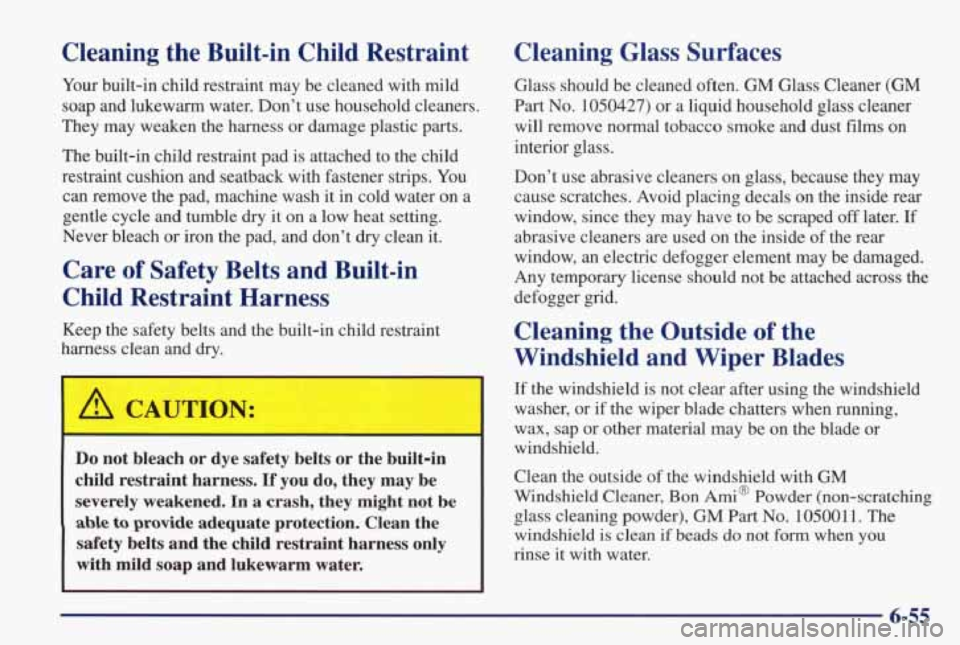
Cleaning the Built-in Child Restraint
Your built-in child restraint may be cleaned with mild
soap and lukewarm water. Don’t use household cleaners.
They may weaken the harness or damage plastic parts.
The built-in child restraint pad is attached to the child
restraint cushion and seatback with fastener strips. You
can remove the pad, machine wash it in cold water on a
gentle cycle and tumble
dry it on a low heat setting.
Never bleach or iron the pad, and don’t
dry clean it.
Care of Safety Belts and Built-in
Child Restraint Harness
Keep the safety belts and the built-in child restraint
harness clean and
dry.
I A CAUTION:
Do not bleach or dye safety belts or the built-in
child restraint harness. If you do, they may be
severely weakened. In a crash, they might not be
able to provide adequate protection. Clean the
safety belts
and the child restraint harness only
with mild soap and lukewarm water.
Cleaning Glass Surfaces
Glass should be cleaned often. GM Glass Cleaner (GM
Part No. 1050427) or a liquid household glass cleaner
will remove normal tobacco smoke and dust films on
interior glass.
Don’t use abrasive cleaners on glass, because they
may
cause scratches. Avoid placing decals on the inside rear
window, since they may have to be scraped
off later. If
abrasive cleaners are used on the inside of the rear
window, an electric defogger element may be damaged.
Any temporary license should not be attached across the
defogger grid.
Cleaning the Outside of the
Windshield and Wiper Blades
If the windshield is not clear after using the windshield
washer, or if the wiper blade chatters when running,
wax, sap or other material may be on the blade or
windshield.
Clean the outside of the windshield with GM
Windshield Cleaner, Bon
Ami@ Powder (non-scratching
glass cleaning powder), GM
Part No. 105001 1. The
windshield is clean if beads
do not form when you
rinse it with water.
Page 360 of 402
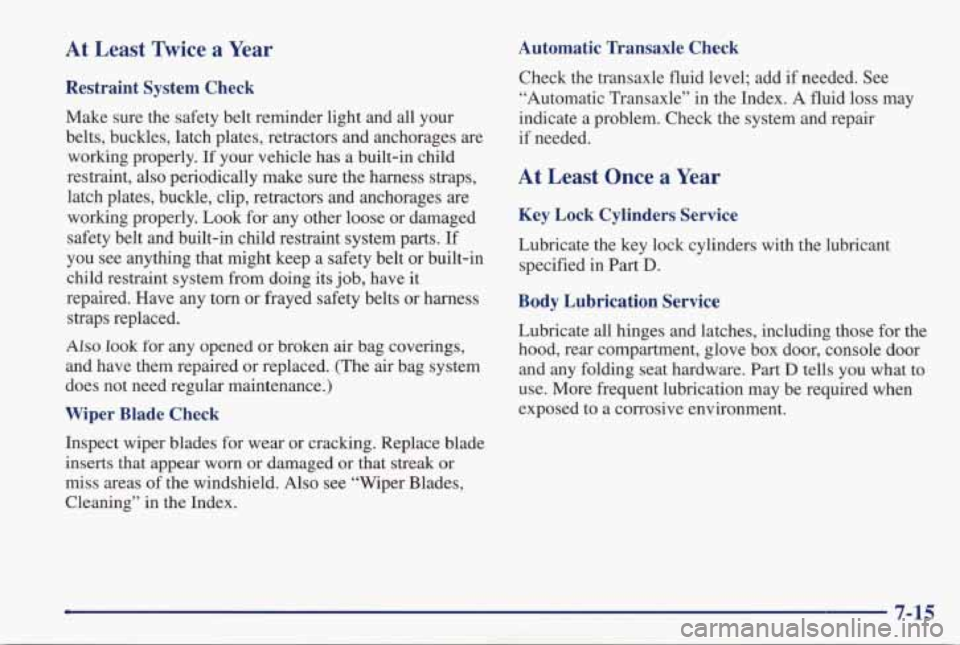
At Least Twice a Year
Restraint System Check
Make sure the safety belt reminder light and all your
belts, buckles, latch plates, retractors and anchorages are working properly. If your vehicle has
a built-in child
restraint, also periodically make sure the harness straps, latch plates, buckle, clip, retractors and anchorages
are
working properly. Look for any other loose or damaged
safety belt and built-in child restraint system parts. If
you see anything that might keep a safety belt or built-in
child restraint system from doing its job, have it
repaired. Have any torn or frayed safety belts or harness
straps replaced.
Also look for any opened or broken air bag coverings,
and have them repaired or replaced. (The air bag system
does not need regular maintenance.)
Wiper Blade Check
Inspect wiper blades for wear or cracking. Replace blade
inserts that appear
worn or damaged or that streak or
miss areas of the windshield. Also see “Wiper Blades,
Cleaning” in the Index.
Automatic Transaxle Check
Check the transaxle fluid level; add if needed. See
“Automatic Transaxle” in the Index. A fluid loss may
indicate a problem. Check the system and repair if needed.
At Least Once a Year
Key Lock Cylinders Service
Lubricate the key lock cylinders with the lubricant
specified in
Part D.
Body Lubrication Service
Lubricate all hinges and latches, including those for the
hood, rear compartment, glove box door, console door
and any folding seat hardware.
Part D tells you what to
use. More frequent lubrication may be required when
exposed to a corrosive environment.
7-15
Page 383 of 402
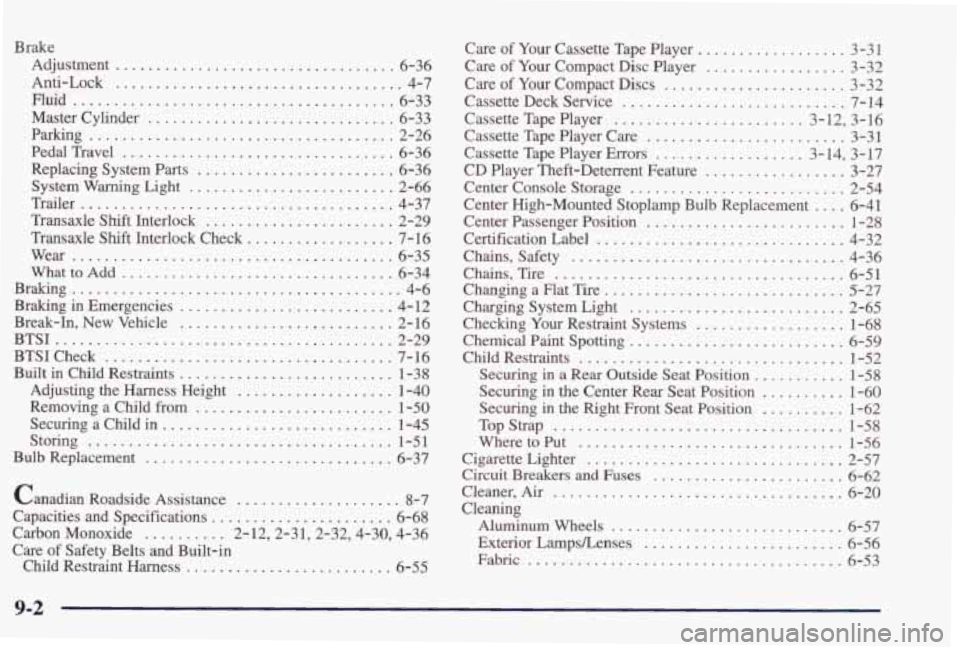
Brake Adjustment
.................................. 6-36
hti-Lock
................................... 4-7
Master Cylinder
.............................. 6-33
Replacing System
Parts ........................ 6-36
System Warning Light
......................... 2-66
Trailer
...................................... 4-37
Transaxle
Shift Interlock ....................... 2-29
Transaxle
Shift Interlock Check .................. 7-16
Wear
....................................... 6-35
WhattoAdd
................................. 6-34
Braking
........................................ 4-6
Braking in Emergencies
.......................... 4- 12
Break-In, New Vehicle
.......................... 2-16
BTSI
......................................... 2-29
Built in Child Restraints .......................... 1-38
Adjusting the Harness Height
................... 1-40
Removing a Child from
........................ 1-50
Securing a Child in
............................ 1-45
Bulb Replacement
.............................. 6-37
Canadian Roadside Assistance
.................... 8-7
Capacities and Specifications ...................... 6-68
Carbon Monoxide
.......... 2-12,2-31,2-32,4-30, 4-36
Child Restraint Harness
......................... 6-55
Fluid
....................................... 6-33
Parking
..................................... 2-26
PedalTravel
................................. 6-36
BTSICheck
................................... 7-16
Storing
..................................... l-51
Care of Safety Belts and Built-in Care
of Your Cassette Tape Player .... ....... 3-31
Care
of Your Compact Disc Player ................. 3-32
Care
of Your Compact Discs ...................... 3-32
Cassette Deck Service
........................... 7-14
Cassette Tape Player
....................... 3.12. 3.16
Cassette Tape Player Care
........................ 3-31
Cassette Tape Player Errors
.................. 3.14. 3.17
CD Player Thefi-Deterrent Feature
................. 3-27
Center Console Storage
.......................... 2-54
Center Passenger Position
........................ 1-28
Certification Label .............................. 4-32
Chains. Safety
................................. 4-36
Chains. Tire
................................... 6-51
Changing a Flat Tire
............................. 5-27
Charging System Light .......................... 2-65
Checking
Your Restraint Systems .................. 1-68
Chemical Paint Spotting .......................... 6-59
Child Restraints
................................ 1-52
Securing
in the Center Rear Seat Position .......... 1-60
Securing
in the Right Front Seat Position .......... 1-62
Cigarette Lighter
............................... 2-57
Center High-Mounted Stoplamp Bulb Replacement
.... 6-41
Securing
in a Rear Outside Seat Position ........... 1-58
TopStrap
................................... l-58
WheretoPut .....................,.........., l-56
Circuit Breakers and Fuses ....................... 6-62
Cleaner. Air
................................... 6-20
Cleaning AluminumWhels
............................ 6-57
Fabric ...................................... 6-53
Exterior
Lampshnses
........................ 6-56
9-2
Page 390 of 402
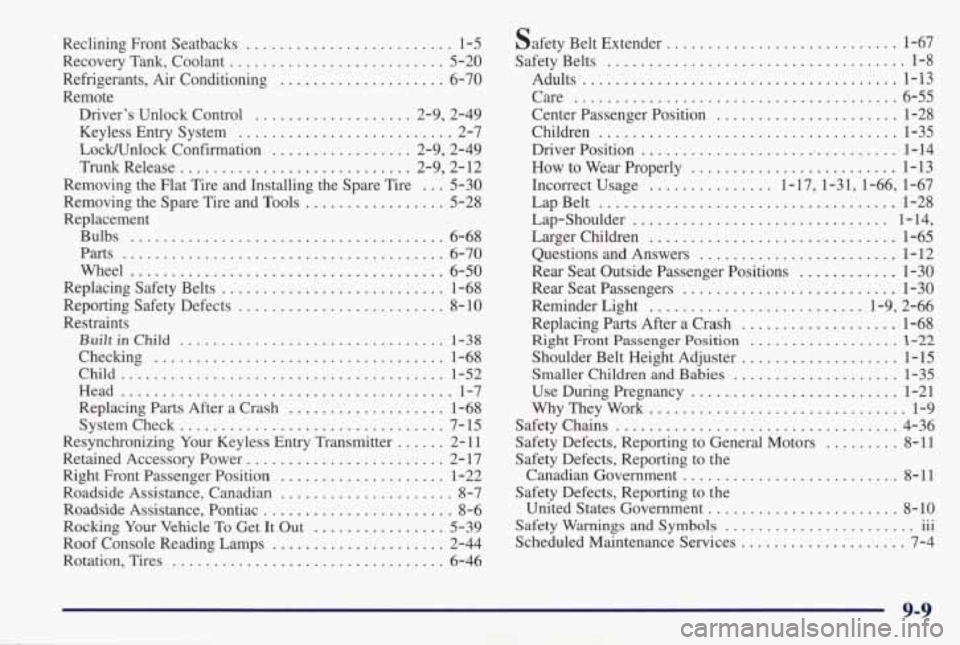
Reclining Front Seatbacks ......................... 1-5
Recovery Tank. Coolant
.......................... 5-20
Refrigerants. Air Conditioning
.................... 6-70
Remote
Driver’s Unlock Control
................... 2.9. 2.49
Keyless Entry System
.......................... 2-7
LocMUnlock Confirmation
................. 2.9. 2.49
Trunk Release ............................ 2.9. 2.12
Removing the Flat Tire and Installing the Spare Tire
... 5-30
Removing the Spare Tire and
Tools ................. 5-28
Replacement
Bulbs
.................................... 6-68
Parts ................. .......... 6-70
Wheel
...................... .......... 6-50
Replacing Safety Belts
........................... 1-68
Reporting Safety Defects
......................... 8-10
Restraints
Built in Child ................................ 1-38
Checking ................................... 1-68
Child
........................... ....... 1-52
Head
......................... ...... 1-7
Replacing
Parts After a Crash ................... 1-68
System Check
................................ 7-15
Resynchronizing
Your Keyless Entry Transmitter ...... 2-1 1
Retained Accessory Power
........................ 2-17
Right Front Passenger Position
.................... 1-22
Roadside Assistance. Canadian
..................... 8-7
Roadside Assistance. Pontiac
....................... 8-6
Rocking Your Vehicle To Get It Out ................ 5-39
Roof Console Reading Lamps
..................... 2-44
Rotation. Tires
................................. 6-46 safety
Belt Extender
.......................... 1-67
Safety Belts
.................................... 1-8
Adults
...................................... 1 . 13
Care
....................................... 6-55
Center Passenger Position
...................... 1-28
Children
.................................... 1-35
Driver Position
............................... 1-14
Incorrect Usage ........ ... 1.17.1.31.1.66. 1.67
LapBelt
.................................... 1-28
Lap-Shoulder
............................... 1.14.
Larger Children
.............................. 1-65
Questions and Answers
........................ 1-12
Rear Seat Outside Passenger Positions
............ 1-30
Rear Seat Passengers
.......................... 1-30
Reminder Light
.......................... 1.9. 2.66
Replacing Parts After a Crash
................... 1-68
Right Front Passenger Position .................. 1-22
Shoulder Belt Height Adjuster ................... 1-15
Smaller Children and Babies
.................... 1-35
Use During Pregnancy
................. ... 1-21
WhyTheyWork
............................... 1-9
Safety Chains
.................................. 4-36
Safety Defects. Reporting to General Motors
......... 8-11
Safety Defects. Reporting to the Canadian Government
........................ 8-11
Safety Defects. Reporting to the United States Government
....................... 8-10
Safety
Warnings and Symbols ....................... iii
Scheduled Maintenance Services
.................... 7-4
How
to Wear Properly
......................... 1-13
9-9
Page 397 of 402
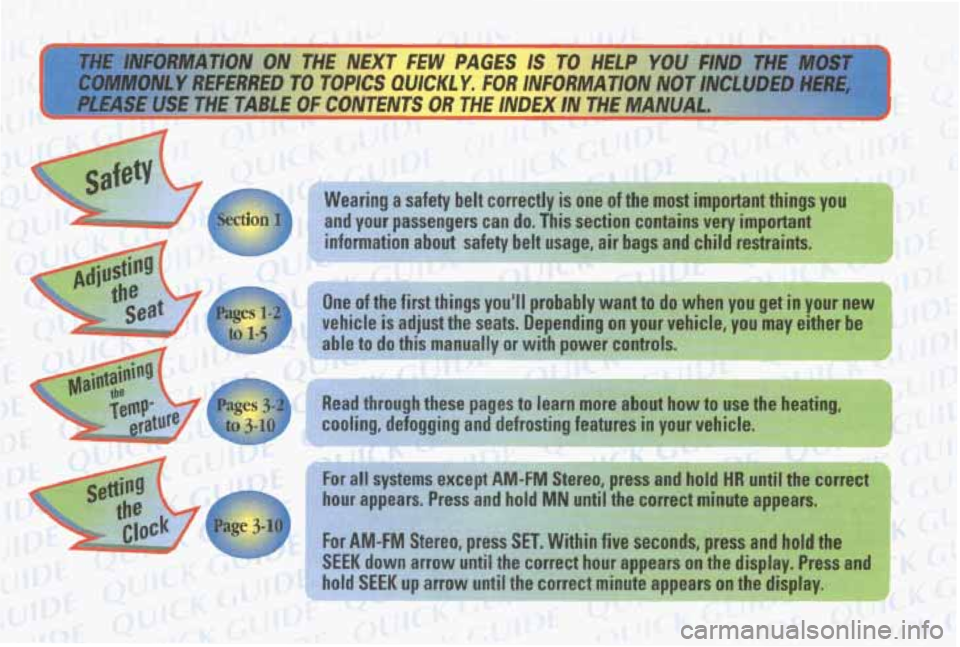
1
iectiol
1, .i~.i..- ~~~~~ ~~~ .-
earing a safety belt correctly is one of the most important things you
d your passengers can do. This section contains very important
ormation about safety belt usage, air bags and child restraints.
,I ; "C , L ,. ~- Ac?lL
One of the first things you'll probably want to do when you get in your neb
icle is adjust the
seats. Depending on your vehicle, you may either be
to do this manually or with power controls. ,, .,. I. !=
E c